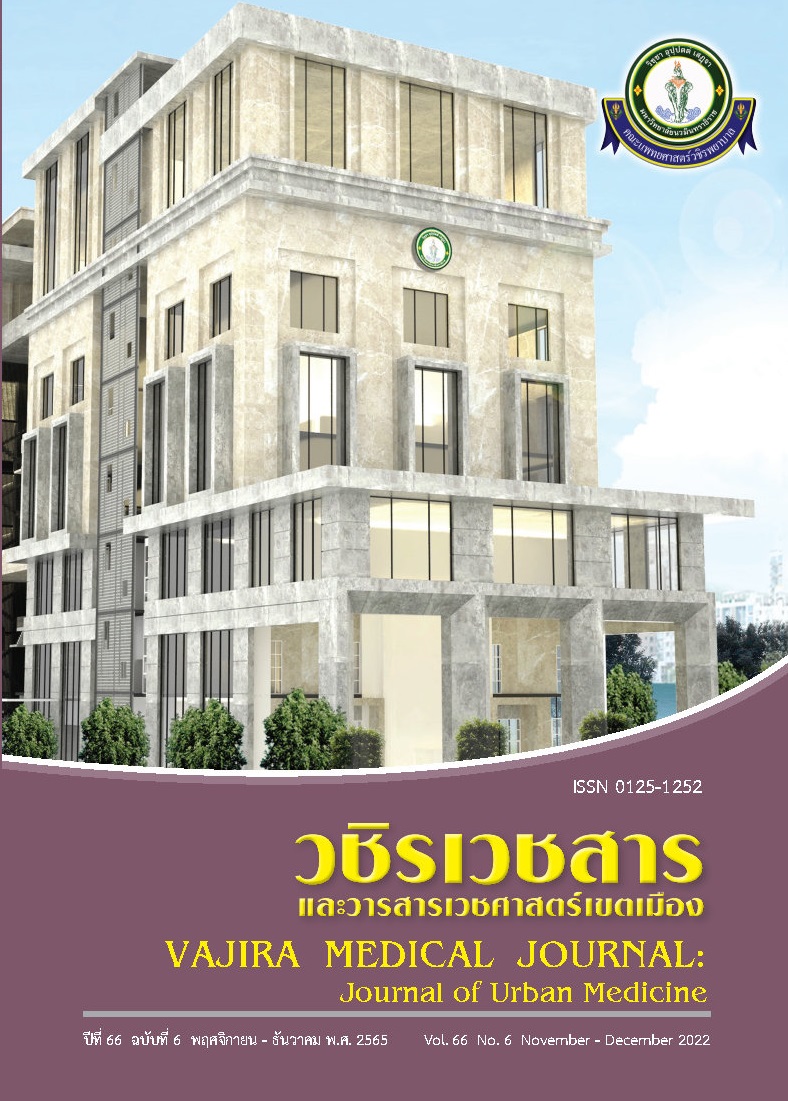Age-Related Neck Circumference in Habitually Snoring Children: A Potential Screening Tool for Obstructive Sleep Apnea in Children
Main Article Content
Abstract
Objective: Neck circumference (NC) is becoming useful for various diseases in adults but not children. Due to a lack of normalized data. This study uses the normalized NC to compare with a patient’s NC as a percentage (%NC) in habitually snoring children to distinguish obstructive sleep apnea (OSA) cases. The ratio of NC and adenoid thickness (NCAR) is hypothetically less in non-overweight OSA children. We proposed this ratio as a parameter to identify OSA in non-overweight children.
Methods: Habitually snoring children who underwent overnight pulse oximetry (overnight SpO2)/ polysomnography (PSG) were eligible. Data gathering included an assessment of participants’ body sizes and AT (from radiographs).
Results: Overall, there were 73 children (65% boys, median age 10.6 y (IQR 7.4-12.7), 52.1% of whom tested positive by either test. In addition, 58.9% of children underwent overnight SpO2, and 20.9% tested positive. Among 30 children tested by PSG, confirmation of OSA diagnosis of varying severity was 96.7%. The positive and non-positive groups did not have statistically significant differences in %NC. In overweight children (n=40), there were no statistically significant differences of %NC between positive (n=27) and non-positive (n=13) results [94.9 (88.3-104.1) vs. 93.4 (89.3-104.4), p-value 0.669]. But the non overweight group, positive children (n=19) had a statistically smaller median NCAR compared to non positive children (n=11); 14.3 (12.7-14.9) vs. 16.2 (14.7-20.3), p-value=0.006. The proposed cut-off NCAR value in predicting non-positive tests in non-overweight children is more than 13.95, with a 47.4% sensitivity and 100% specificity. The positive predictive value is 100%, and the negative predictive value is 68.6%.
Conclusion: There was no statistically significant difference in %NC of the overall OSA vs. non OSA children and the overweight OSA vs. non-OSA children. In the non-overweight group, NCAR was significantly smaller in positive children.
Downloads
Article Details

This work is licensed under a Creative Commons Attribution-NonCommercial-NoDerivatives 4.0 International License.
References
Anuntaseree W, Kuasirikul S, Suntornlohanakul S. Natural history of snoring and obstructive sleep apnea in Thai school-age children. Pediatr Pulmonol 2005;39(5):415-20.
Anuntaseree W, Rookkapan K, Kuasirikul S, Thongsuksai P. Snoring and obstructive sleep apnea in Thai school-age children: prevalence and predisposing factors. Pediatr Pulmonol 2001;32(3):222-7.
Veeravigrom M, Desudchit T. Prevalence of sleep disorders in Thai children. Indian J Pediatr 2016;83(11):1237-41.
Preutthipan A, Sritippayawan S, Kuptanon T. Thai guideline for childhood obstructive sleep apnea [internet]. 2015 [cited 2018 May 8]. Available from:https://drive.google.com/file/d/1UQ8NNd_ZRCFyFAdXn4hi0IfvwPEbym3t/view
Brouillette RT, Morielli A, Leimanis A, Waters KA, Luciano R, Ducharme FM. Nocturnal pulse oximetry as an abbreviated testing modality for pediatric obstructive sleep apnea. Pediatrics 2000;105(2):405-12.
Stradling JR, Crosby JH. Predictors and prevalence of obstructive sleep apnoea and snoring in 1001 middle aged men. Thorax 1991;46(2):85-90.
Epstein LJ, Kristo D, Strollo PJ Jr, Friedman N, Malhotra A, Patil SP, et al. Clinical guideline for the evaluation, management and long-term care of obstructive sleep apnea in adults. J Clin Sleep Med 2009;5(3):263-76.
Chung F, Yegneswaran B, Liao P, Chung SA, Vairavanathan S, Islam S, et al. STOP questionnaire: a tool to screen patients for obstructive sleep apnea. Anesthesiology 2008;108(5):812-21.
Ho AW, Moul DE, Krishna J. Neck circumferenceheight ratio as a predictor of sleep related breathing disorder in children and adults. J Clin Sleep Med 2016;12(3):311-7.
Srikanjana J. Thai children standard sizes [internet]. 2013 [cited 2018 May 3]. Available from: http://www.research.rmutt.ac.th/wp-content/uploads/2013/03/5-Thai-ChildrenStandard-Sizes-Dr.Srikanjana.pdf.
Ministry of Public Health. Standard growth chart for children [internet]. 2021 [cited 2021 Dec 15]. Available from:https://nutrition2.anamai. moph.go.th/th/kidgraph
Jain A, Sahni JK. Polysomnographic studies in children undergoing adenoidectomy and/or tonsillectomy. J Laryngol Otol 2002;116(9):711-5.
Berry RB, Budhiraja R, Gottlieb DJ, Gozal D, Iber C, Kapur VK, et al. Rules for scoring respiratory events in sleep: update of the 2007 AASM Manual for the Scoring of Sleep and Associated Events. Deliberations of the sleep apnea definitions task force of the American Academy of Sleep Medicine. J Clin Sleep Med 2012;8(5):597-619.
Nixon GM, Kermack AS, Davis GM, Manoukian JJ, Brown KA, Brouillette RT. Planning adenotonsillectomy in children with obstructive sleep apnea: the role of overnight oximetry. Pediatrics 2004;113(1 Pt 1):e19-25.
Beck SE, Marcus CL. Pediatric polysomnography. Sleep Med Clin 2009;4(3):393-406.
Rattanachuek S, Thaweekul P, Iamopas O, Suthutvoravut U. Thai guideline for childhood obesity [internet]. 2014 [cited 2018 Oct 18]. Available from: https://drive.google.com/file/d/1qIHLECHIYzwobw3sj5ChRcLnFKz4lR1X/view
Narang I, Al-Saleh S, Amin R, Propst EJ, Bin-Hasan S, Campisi P, et al. Utility of neck, height, and tonsillar size to screen for obstructive sleep apnea among obese youth. Otolaryngol Head Neck Surg 2018;158(4):745-51.
de Sousa Caixêta JA, Saramago AM, de Cácia Pradella-Hallinan ML, Moreira GA, Tufik S, Fujita RR. Waist-to-height ratio distinguish obstructive sleep apnea from primary snoring in obese children. Sleep Breath 2015;19(1):231-7.
Katz S, Murto K, Barrowman N, Clarke J, Hoey L, Momoli F, et al. Neck circumference percentile: a screening tool for pediatric obstructive sleep apnea. Pediatr Pulmonol 2015;50(2):196-201.
Katz SL, Vaccani JP, Barrowman N, Momoli F, Bradbury CL, Murto K. Does neck-to-waist ratio predict obstructive sleep apnea in children? J Clin Sleep Med 2014;10(12):1303-8.
Chou CH, Kang KT, Weng WC, Lee PL, Hsu WC. Central sleep apnea in obese children with sleep-disordered breathing. Int J Obes (Lond) 2014;38(1):27-31.
Gulotta G, Iannella G, Vicini C, Polimeni A, Greco A, de Vincentiis M, et al. Risk factors for obstructive sleep apnea syndrome in children: state of the Art. Int J Environ Res Public Health 2019;16(18):3235.


